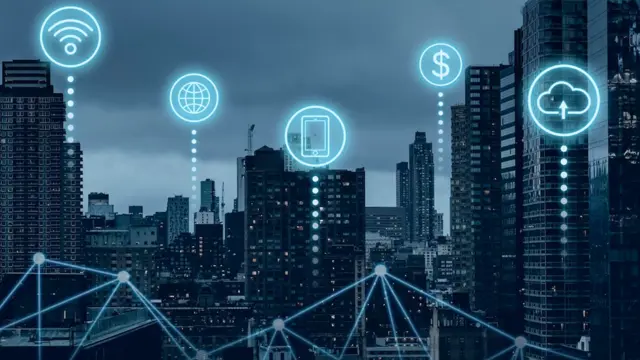- Reed Courses Certificate of Completion - Free
- Uplatz Certificate of Completion - Free

Modern Communication Systems
Uplatz
Self-paced videos, Lifetime access, Study material, Certification prep, Technical support, Course Completion Certificate
Summary
Overview
Certificates
Reed Courses Certificate of Completion
Digital certificate - Included
Will be downloadable when all lectures have been completed.
Uplatz Certificate of Completion
Digital certificate - Included
Course Completion Certificate by Uplatz
Curriculum
Course media
Description
Modern Communication Systems - Course Syllabus
Module 1: Foundations of Mobile CommunicationEvolution of Mobile Communication (Parts I & II)
GSM (Parts I–III)
EGPRS
Third Generation Network (Parts I–III)
HSPA (Parts I & II)
Practical 2G–3G–4G (Parts I–V)
Introduction to HSPDA
Introduction to 4G-LTE (Parts I–III)
4G-LTE Deep Dive (Parts I–VI)
LTE-Advanced (LTE-A) (Parts I & II)
Wireless Spectrum and its Implementation in 5G (Parts I–III)
Wireless Technology: 5G and Beyond (Parts I & II)
Cognitive Radio Networks (Parts I–IV)
From 5G to 6G (Parts I & II)
6G Wireless Communication Systems (Parts I & II)
6G Architectures, Applications, and Challenges (Parts I & II)
Future of Wireless Communication with 6G
Network of the Future (Parts I–III)
AI and ML in the 5G and 6G Era
Indoor Radio Planning (Parts I–III)
Distributed Antenna Systems (Parts I–VI)
Designing Indoor DAS Solutions (Parts I–VII)
Tools for Indoor Radio Planning (Parts I & II)
Tunnel Radio Planning (Parts I–IV)
Covering Indoor Users from Outdoor Network (Parts I & II)
Small Cell Indoors (Parts I & II)
Planning Procedure
Traffic Dimensioning (Parts I & II)
Noise Considerations (Parts I–III)
The Link Budget (Parts I & II)
Optimization of Radio Resources
Application Examples (Parts I–III)
Mobile Network Engineering (Parts I–III)
Network Function Virtualization (NFV) (Parts I–IV)
Cybersecurity in the Digital Transformation Era (Parts I & II)
Who is this course for?
Engineering Students:
Undergraduate and postgraduate students specializing in Electrical Engineering, Electronics and Communication Engineering, Telecommunication Engineering, or Computer Science.
Those interested in understanding the principles, technologies, and applications of modern communication systems.
Professionals in the Telecom Industry:
Engineers, technicians, and researchers working in telecommunications, networking, or wireless communication.
Professionals looking to update their knowledge on emerging technologies like 5G, IoT, satellite communication, and optical communication.
Academics and Researchers:
Faculty members and researchers in the field of communication systems who want to deepen their understanding or explore advanced topics.
Individuals pursuing research in areas like signal processing, wireless networks, or information theory.
Tech Enthusiasts and Hobbyists:
Individuals with a strong interest in communication technologies and a background in STEM (Science, Technology, Engineering, and Mathematics).
Those who want to learn about the latest trends and innovations in communication systems.
Entrepreneurs and Innovators:
Startups or entrepreneurs working on communication-related products or services.
Individuals exploring opportunities in IoT, smart devices, or telecommunication infrastructure.
IT and Networking Professionals:
Professionals working in IT or networking who want to expand their knowledge of communication systems, including wireless and wired networks.
Requirements
Zeal and enthusiasm to make it big!
Career path
- Telecommunications Engineer
- Network Engineer
- Electronics Engineer
- Electrical Engineer
- Software Developer/Engineer
- Network Administrator
- Systems Architect
- Data Analyst
- Cybersecurity Specialist
- VoIP Engineer
- UX/UI Designer
- IoT Developer
- Satellite Communication Engineer
- Unified Communication Specialist
- Voice Assistant Developer
- Embedded Engineer
- Digital Design Specialist
- Telecom Engineer
- AI Developer
Questions and answers
Currently there are no Q&As for this course. Be the first to ask a question.
Reviews
Currently there are no reviews for this course. Be the first to leave a review.
Legal information
This course is advertised on Reed.co.uk by the Course Provider, whose terms and conditions apply. Purchases are made directly from the Course Provider, and as such, content and materials are supplied by the Course Provider directly. Reed is acting as agent and not reseller in relation to this course. Reed's only responsibility is to facilitate your payment for the course. It is your responsibility to review and agree to the Course Provider's terms and conditions and satisfy yourself as to the suitability of the course you intend to purchase. Reed will not have any responsibility for the content of the course and/or associated materials.
FAQs
Interest free credit agreements provided by Zopa Bank Limited trading as DivideBuy are not regulated by the Financial Conduct Authority and do not fall under the jurisdiction of the Financial Ombudsman Service. Zopa Bank Limited trading as DivideBuy is authorised by the Prudential Regulation Authority and regulated by the Financial Conduct Authority and the Prudential Regulation Authority, and entered on the Financial Services Register (800542). Zopa Bank Limited (10627575) is incorporated in England & Wales and has its registered office at: 1st Floor, Cottons Centre, Tooley Street, London, SE1 2QG. VAT Number 281765280. DivideBuy's trading address is First Floor, Brunswick Court, Brunswick Street, Newcastle-under-Lyme, ST5 1HH. © Zopa Bank Limited 2025. All rights reserved.

